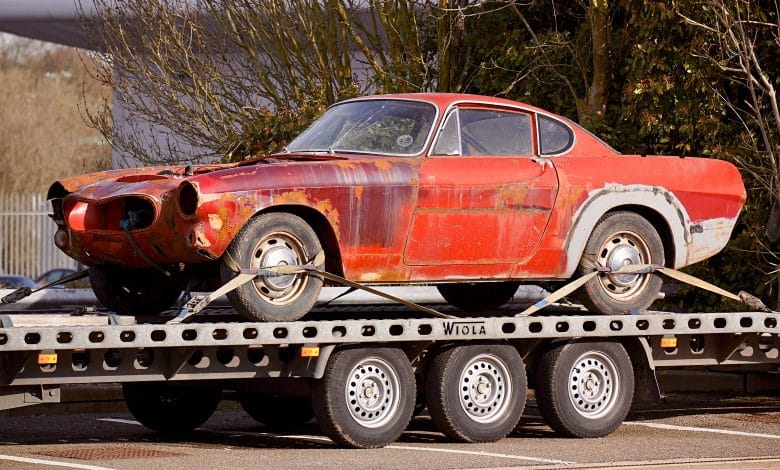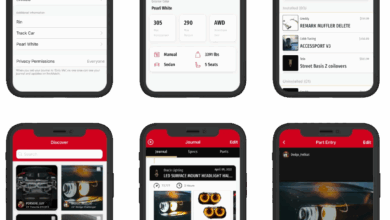Selecting A Tow Vehicle For Your Car

Once you reach a certain point as a car enthusiast you start to consider a tow vehicle. It often for a dedicated race car, more comfort when traveling to events or to get a little more life out of your project car that is becoming a little more prone to breaking as you push the limits. At some point the reality sets in that you need to consider your options.
In this post we break down the technical details you need to know when selecting a tow vehicle, some options in cars and if you are really going big, what you need to know about RV tow selection.
Trucks and SUVs As Car Tow Vehicles
We’re going to cut to the chase here. While we highly recommend reading the entire article and understanding all of the towing technical details. There are safety impacts if you do not have the right setup. Still, most of us are just curious which models we can buy to get the job done. So we’re going to lay out a few and encourage you to then validate it can get the job done right/safely before buying and actually towing.
While there are dozens of vehicles that can tow under 6000lbs unless you are into being risky (which we couldn’t recommend with towing) or towing a very light car and trailer, we wouldn’t recommend going any lower. In fact, even 6,000 lbs isn’t enough in a lot of situations. We’d recommend not less than 7,500 lbs for localized towing and would recommend over 10,000 lbs for serious towing or enclosed trailers.
Popular Tow Vehicles For Cars
Below are some of the popular two vehicles for cars broken up into a SUVs or Trucks that can tow over 6000lbs as well as vehicles that can go over 10000 lbs for those who need more. It’s not an exhaustive list, we leave out some rather obscure ones that may technically work (like the Lamborghini SUV).
We also based it on recent models. Of course a number of these you can go back to older generations and they are still capable, but you’ll want to double check trim lines, engines and features needed.
Vehicles With Over 10,000lbs Towing
We are starting big, and even then we really aren’t going beyond the 1500/2500 trucks. Get into the duelies and 3500+ series you can go even further.. If you are going to go big and get a fully enclosed race trailer with distant towing you should consider one of these vehicles. Over 10,000 lbs of towing opens up a lot options for the more serious car enthusiast hauler. The list is also essentially all trucks. If you need beyond these, you probably shouldn’t be reading this blog, you should be writing it.
| Vehicle | Towing Capacity | Trim/Features Needed For Listed Towing Capacity | |
| Ford F150 | 13,000 lbs | Towing package with 3.73 rear end. Note: AWD and some trim lines have lower towing capacity. | |
| Dodge Ram | 12,750 lbs | Towing package with 3.92 rear end and Hemi motor for highest capacity, | |
| Chevy Silverado | 12,200 lbs | Towing package with 6.2 liter motor and 3.42 rear end required for highest capacity. 5.3 with 3.42 rear end and towing package can handle over 11,000 lbs. | |
| Toyota Tundra | 10.100 lbs | Towing package with 4.3 rear end in the Limited models. Note: 4WD and some other trim lines have lower towing capacity. | |
| F250 Super Duty | 15,000 lbs (gas), 18,000 (diesel) | All models are over 10,000 lbs. | |
| RAM 2500 | 19,370 lbs | All models are over 10,000 lbs. | |
| Chevy Silverado | 14,500 lbs (gas), 15,400 (diesel) | Recommend towing package, hitch is an option and not always included |
SUVs with Over 6000lbs
| Vehicle | Towing Capacity | Trim/Features Needed For Listed Towing Capacity | |
| Nissan Armada | 8,500 lbs | Recommend towing package, hitch is an option and not always included | |
| Toyota Landcruiser | 8,100 lbs | All models include towing package and hitch | |
| Chevy Suburban | 8,300 lbs | Towing package with 3.42 rear end required | |
| Chevy Tahoe | 8,500 lbs | Max trailer package required | |
| GMC Yukon | 8,500 lbs | Max trailer package with 3.42 rear end. All Denali models include tailer package and 6.2 V8. Note: some models like AWD, Denali have slightly lower maximum capacity. | |
| Dodge Durango | 8,700 lbs | SRT package for highest towing capacity | |
| Infinity QX80 | 8,500 lbs | Recommend towing package, hitch is an option and not always included | |
| Porsche Cayene | 7,716 lbs | All models, including the base V6 turbo can tow 7,716 pounds. | |
| Ford Expedition | 9,300 lbs | Heavy duty trailer package with 3.73 rear end. AWD and some trim lines capacity are slightly lower. | |
| Audi Q7 | 7,700 lbs | Required towing package |
There are a number of additional vehicles we didn’t cover here. Some are corporate cousins of models listed (i.e. Escalade is similar to the Suburban, Navigator is similar to the Expedition). There are also a number of Range Rovers and other specialty luxury vehicles that qualify.
Trucks with Over 6000lbs
If you don’t need to haul as many people, or want something smaller and less expensive then SUVs and heavy duty trucks, here is a list of great truck options that can tow 6,000 lbs or more. This list is in addition to the vehicles over 10,000lbs.
| Nissan Titan | 9,400 lbs | Recommend towing package, hitch is an option and not always included. | |
| Chevy Colorado/GMC Canyon | 7,000 lbs (gas), 7,700 lbs (diesel) | 3.6 V6 w/ towing package required for 7,000 lbs, turbo-diesel w/ towing package for 7,700 lbs. | |
| Toyota Tacoma | 6,400 lbs | Towing package and V6 required |
Trucks are more plentiful and less expensive for towing than SUVs. SUVs offer some flexibility for families and other daily uses trucks may not. But if you don’t need the enclosed space in the back, here are some great pickups that will get the job done.
RVs As Car Tow Vehicles
If you are a regular at car events or races we’ve all dreamed of being the guy with the RV chillin’ in the air conditioning between races. It’s an imagine few of us can escape. As this dream becomes a potential reality, the opportunity to own an RV with a trailer starts to feel real.
Carefully Review Towing Numbers For RVs
When considering an RV as a tow vehicle you have to pay attention to the numbers very closely. While all tow vehicles are limited to the Gross Combined Weight Rating (GCWR), which we explain below. Entry level RVs are notorious for publishing a towing capacity you couldn’t realistic ever achieve because of their GCWR.
Like trucks towing capacity often maximized by assuming the vehicle is empty. For a truck the delta between loaded and towing capacity sometimes is only 500 or so pounds. Even if you fully load with two adults, kids and luggage you’ll stretch to top 1000lbs.
RVs on the other hand tend to carry 1500+ lbs of extra weight before you consider passenger and luggage. Water, food, waste water, dishes, mattresses, TVs. RVs often have huge fuel tanks as well. An RV with a 6,000 lb towing capacity might realistically be able to tow 3,500 lbs when loaded for actual use. While this may still be higher than the weight of your car when you consider the weight of the trailer only the lightest of cars can effectively be towed by most driveable RVs with 6,000lb towing capacity.
If you are considering an RV as your tow vehicle, definitely spend the time to read through the technical details of towing below and pay close attention to the GCWR and other limits, not just get caught up in “towing capacity” numbers.
RV Tow Vehicle Considerations
Most smaller RVs are based on van chassis, not truck chassis. This is a big part of the reason why they have limited towing capacities compared to their relative size. While they often have plenty of engine (V8s and V10s are very common) they simply lack the rest of the chassis infrastructure needed for a high towing capacity.
However, there are a number of RVs based on truck chassis. Some include diesel engines. The downside is the price point is often significantly higher. This is partially because the truck chassis are most expensive foundations. It’s also partly because they can command a higher premium so most of those RVs are targeted at a higher price point. While you can find plenty of good values on used RVs, most high towing capacity RVs originally sold for well over $100K new.
Tow Vehicle Technical Details and Terms
Regardless of whether you are looking for a truck, SUV or RV for a tow vehicle, you first must understand the terms, concepts and limits in order to select the right vehicle. There concepts apply no matter what you are towing, even if it’s not a car, or what you are towing with. Also, these concepts won’t necessarily speak to the quality, age or wear of the components. Don’t confuse capability with reliability.
Towing Capacity
Everyone loves a big towing capacity. Vehicles routinely claim 5,000, 6,000, 7,000, 8,000, 9,000 lbs of towing capacity or more. Get into diesels and these numbers can easily get into the 5 digits.
Towing Capacity simply put is the maximum pull weight the vehicle and chassis can take. It’s based on a lot of factors, including engine torque, chassis capability, transmission, axle rations, vehicle weigh. However what you might not realize is that maximum towing capacity also may have dependencies. It may require weight distributing hitch, trailer brakes and other requirements.
The number may exceed the total weight of the vehicle can actually operate at. Yes, you read that right. This is particularly common in the world of RVs where the towing capacity can only be reached if the vehicle is totally empty. Don’t worry, we’ll explain a little more how this works and how to avoid it.
Gross Combined Weight Rating (GCWR)
The Gross Combined Weight Rating (GCWR) is the total maximum weight the tow vehicle and chassis can safely pull. This weight includes all passenger, cargo, weight of the trailer, weight of what is being towed, anything on the tow trailer also being towed.
This number is just as important as the towing capacity. It’s the total weight the vehicle can pull. If you take more passengers or cargo you have to take that number off of the total.
To determine your vehicles GCWR you have to take the gross weight of your vehicle, trailer and anything you are towing. Add in anything you have as cargo and any passengers. Remember to add 50 lbs to whatever number that person in your life who always lies about their weight. You then compare that to the GCWR. If you are over you run the risk or prematurely wearing out parts, have trouble controlling your trailer or even create a safety risk.
Gross Vehicle Weight Rating (GVWR)
Gross Vehicle Weight Rating (GCWR) is the total weight of the vehicle plus any cargo or passengers excluding anything being towed. This number is generally used to calculate the GCWR, but also factors into weight distribution and axle rating. Regardless of the manufacturers listed towing capacity the “actual” towing effective towing capacity of the vehicle at any given time is GCWR – GVWR. This is particularly useful for understanding the effective towing capacity of an RV.
Tongue Weight (TW)
Tongue Weight (TW) is the effective weight that pulls on the tongue (hitch and receiver) of the tow vehicle. It’s listed as a maximum capability of both the tow vehicle and the trailer.
You can calculate it as generally 10 to 15% of the loaded weight of the trailer. Also, the way the trailer is loaded can effect the tongue weight. Too much weight in the back may create more pull on the tongue. You can avoid this generally by placing 60% of the load forward of the trailer axles.
Gross Axle Weight Rating (GAWR)
Gross Axle Weight Rating is the maximum weight that can be placed on the axles of a vehicle or trailer. While important for the two vehicle, this is commonly references regarding the maximum payload weight of a trailer is generally limtied by the maximum weigh the axles can handle. If you have a heavy car, or a lot of additional payload you want to carry on your trailer, this is particularly important to consider.
Gross Trailer Weight (GTW)
This is the total weight of the trailer and the payload. So this would be car, any fluids, any cargo, and the weight of the trailer itself.
Other Towing Weight Terms To Known
Below are some additional terms to know. They are commonly referenced to potentially calculate towing capacity for certain uses.
Dry Weight: Weight of the empty vehicle plus any fluids (including gas)
Payload: Weight of anything in the bed/trunk/cargo area of a vehicle that isn’t passengers or part of the Dry Weight.
Curb Weight: The empty weight of your vehicle as it rolls of the manufacturing line.
Receiver Weight Rating: This is the tongue weight supported by the receive, or the piece that goes into the hitch that the trailer actually attaches to.
Selecting The Right Tow Vehicle For Your Car
When you are selecting the right two vehicle for your car you should make sure you have a complete picture of what you’ll be towing before selecting. We recommend considering the weight of the car, payload and the type of trailer you want to use. The type of trailer is a huge factor in the calculation.
We outline some common combinations to speed the process along. However, to customize the setup for yourself here is how we recommend going about the process.
Vehicle Being Towed
Start with the curb weight of the vehicle you’ll be towing. This is the vehicle plus any fluids, like gas. You can always go to the drag strip a weigh the vehicle, but most curb weights (or close to) are available online or in the original owners manual as well.
Any Trailer Payload
What else do you need to take on the trailer? Tools? Spare parts? Spare Tires and Wheels. Add those up. For a quick haul or Autocross this number may not be significant, but if you are a dedicated racer carrying a weekends worth of spare parts, extra fuel, extra tires, brakes, etc. This could easily be 100s or even 1000s of lbs.
Trailer
Most open car haulers in the 16-20 foot range (typical for carrying cars) weigh 1750-2500 lbs. Open titl trailers generally weigh 2750-4000 lbs. Enclosed trailers generally weight 3000-6000 lbs (or higher). One with a kitchen and bathroom is easily 7000 lbs (yes, those exist).
So you can imagine if you have 6,000 lb towing capacity vehicle and buy a nice 3000 lb trailer, your car and all other payload can’t exceed 3000 lbs. Given most cars in the last 30 years weight 3000+ pounds you can see how quickly this becomes an issue.
These are typical range to assume for considering what to buy. However, check your specific trailer as you are shopping and leave yourself some room as you calculate capacity.
Calculate Your Needed Towing Capacities
Once you know this information you’ll want to add all of the numbers together to get the handful of numbers you’ll need to understand the tow capacities you need. This is the Gross Trailer Weight (GTW) we reference above.
Note we say needed towing capacities and not towing capacity. Towing capacity is an industry term which you’ll often hear, but that is not what we are discussing here which is calculating tow capacities needed. While we will factor this into our needs, we are actually calculating several different numbers that we’ll use when looking at our tow vehicles to help ensure we select the right one.
Needed Tow Capacity
The combined weight of the car being towed, the trailer and any payload is the needed tow capacity. While this is not directly related to the towing capacity that may be specified by the tow vehicle, you of course will need a vehicle with a towing capacity that meets or exceeds this number.
Needed Tongue Weight Capacity
You’ll want to calculate 10% (accepted maximum), 15% (safe side) of the tow capacity needed to get an estimated tongue weight capacity. This will help ensure the tongue weight of the vehicle, trailer and hitch you’ve selected can handle the weight of what you want to tow.
Validating Tow Vehicle’s Capabilities
Now that you know what you need, time is validate the vehicle can handle it. To do this you’ll need to gather some of the information we talk about above.
- Towing Capacity
- Gross Combined Vehicle Weight Rating
- Dryweight (of the towing vehicle)
What you do is subtract the Dryweight + any the weight of driver, passenger or other items being carried of the vehicle from the GCWR. The LESSER of it and the rated towing capacity is your Vehicles Net Towing Capabilities.
This number needs to meet or exceed your Needed Tow Capacity. we calculated above. The difference is also any extra weight you can potentially carry.
We recommend trying not to exceed 75% of the towing capacity with the Needed Tow Capacity on longer tows (over a few hours of sustained driving) where possible. This will both help limit wear on components such as the transmission and driveline. It will also help increase safety. This is not a hard requirement and only a general rule of thumb.
Towing Components
While we are not going to deep dive into it in this post, here are a few other things you should be aware of when selecting a tow vehicle.
Hitch Class and Rating
In addition to all of the weight rating and capabilities we discussed above, its the hitch that bolts to the chassis of the tow vehicle. Hitches are rated based on strength of materials, mounting points and receiver size into classes. The class of the hitch rates the maximum towing and tongue weights of the trailer that can be attached.
The hitch class and weight rating are still limited by all of the other factors we discussed above – towing capacity, GCWR, etc. So as with all of these, your actual capability is always the LEAST of all of the factors.
| Class | Receiver Size | Towing Weight | Tongue Weight |
| Class 1 – Light Duty | 1.25″ | 2,000 lbs | 200 lbs |
| Class 2- Medium Light Duty | 1.25″ | 3,500 lbs | 350 lbs |
| Class 3 – Medium Duty | 2″ | 8,000 lbs | 800 lbs |
| Class 4 – Heavy Duty | 2″ | 10,000 lbs | 1000 lbs |
| Class 5 – Professional | 2 to 2.5″ | 16,000 to 20,000 lbs | 2,400 to 2,700 lbs |
Class rates are the maximum for the claimed class. One thing to note is that an individual hitch can advise a LOWER weight rating than the maximum their class allows. So a class 4 hitch could say 9,000 lbs. However, a Class 2 hitch could not claim 9,000 lbs.
Weight Distributing Hitches
A good thing to know is that many newer vehicles to meet their maximum towing capacity may require weight distributing hitches. The best way I’ve seen this described is think of wheel barrel handles. Your ability to balance the weight when the ground and load are uneven makes it easier to tow high capacity. It prevents heavy loads from shifting putting too much stress on one side of the tow vehicles chassis.
Generally most weight distributing hitches attach to the vehicle hitch, almost like an extension. They are also generally only recommended when towing beyond 7,000 lbs.
Ball and Receivers
Balls are generally attached to a “receiver”. The receiver is the piece that goes into the hitch. Balls and Receivers can be sold separately, or in combination. Some receivers have selected tow ball sizes. Some trailers don’t even use a ball to attach at all, so be sure to check your trailers requirements.
Be sure to get the correct sized ball for your tow vehicle and a receiver that meets or exceeds your towing capacity.
Disclaimers
Without getting to legalese here, lets just say there is a LOT to towing besides just the stats. As we’ve discovered through the process of buying our own trailer and tow vehicle; it feels like a totally different world. There are unique insurance, titling and registration requirements. There is also a lot of ways to get things wrong. And we haven’t even begun to discuss things like proper tie downs and ensuring load weight distribution. We’ll hit more of these topics soon.





